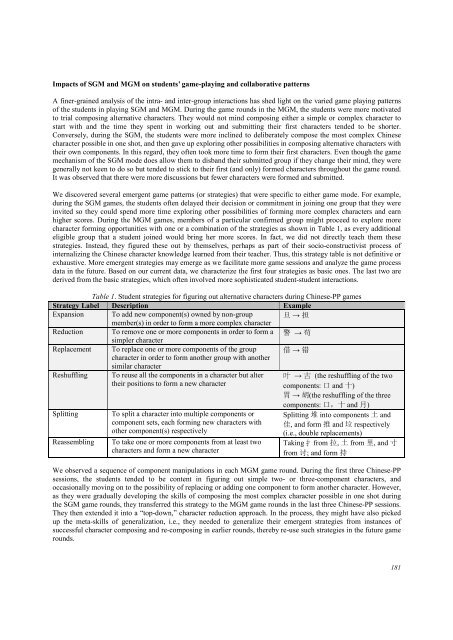Download Complete Issue in PDF - Educational Technology & Society
Download Complete Issue in PDF - Educational Technology & Society
Download Complete Issue in PDF - Educational Technology & Society
You also want an ePaper? Increase the reach of your titles
YUMPU automatically turns print PDFs into web optimized ePapers that Google loves.
Impacts of SGM and MGM on students’ game-play<strong>in</strong>g and collaborative patterns<br />
A f<strong>in</strong>er-gra<strong>in</strong>ed analysis of the <strong>in</strong>tra- and <strong>in</strong>ter-group <strong>in</strong>teractions has shed light on the varied game play<strong>in</strong>g patterns<br />
of the students <strong>in</strong> play<strong>in</strong>g SGM and MGM. Dur<strong>in</strong>g the game rounds <strong>in</strong> the MGM, the students were more motivated<br />
to trial compos<strong>in</strong>g alternative characters. They would not m<strong>in</strong>d compos<strong>in</strong>g either a simple or complex character to<br />
start with and the time they spent <strong>in</strong> work<strong>in</strong>g out and submitt<strong>in</strong>g their first characters tended to be shorter.<br />
Conversely, dur<strong>in</strong>g the SGM, the students were more <strong>in</strong>cl<strong>in</strong>ed to deliberately compose the most complex Ch<strong>in</strong>ese<br />
character possible <strong>in</strong> one shot, and then gave up explor<strong>in</strong>g other possibilities <strong>in</strong> compos<strong>in</strong>g alternative characters with<br />
their own components. In this regard, they often took more time to form their first characters. Even though the game<br />
mechanism of the SGM mode does allow them to disband their submitted group if they change their m<strong>in</strong>d, they were<br />
generally not keen to do so but tended to stick to their first (and only) formed characters throughout the game round.<br />
It was observed that there were more discussions but fewer characters were formed and submitted.<br />
We discovered several emergent game patterns (or strategies) that were specific to either game mode. For example,<br />
dur<strong>in</strong>g the SGM games, the students often delayed their decision or commitment <strong>in</strong> jo<strong>in</strong><strong>in</strong>g one group that they were<br />
<strong>in</strong>vited so they could spend more time explor<strong>in</strong>g other possibilities of form<strong>in</strong>g more complex characters and earn<br />
higher scores. Dur<strong>in</strong>g the MGM games, members of a particular confirmed group might proceed to explore more<br />
character form<strong>in</strong>g opportunities with one or a comb<strong>in</strong>ation of the strategies as shown <strong>in</strong> Table 1, as every additional<br />
eligible group that a student jo<strong>in</strong>ed would br<strong>in</strong>g her more scores. In fact, we did not directly teach them these<br />
strategies. Instead, they figured these out by themselves, perhaps as part of their socio-constructivist process of<br />
<strong>in</strong>ternaliz<strong>in</strong>g the Ch<strong>in</strong>ese character knowledge learned from their teacher. Thus, this strategy table is not def<strong>in</strong>itive or<br />
exhaustive. More emergent strategies may emerge as we facilitate more game sessions and analyze the game process<br />
data <strong>in</strong> the future. Based on our current data, we characterize the first four strategies as basic ones. The last two are<br />
derived from the basic strategies, which often <strong>in</strong>volved more sophisticated student-student <strong>in</strong>teractions.<br />
Table 1. Student strategies for figur<strong>in</strong>g out alternative characters dur<strong>in</strong>g Ch<strong>in</strong>ese-PP games<br />
Strategy Label Description Example<br />
Expansion To add new component(s) owned by non-group<br />
member(s) <strong>in</strong> order to form a more complex character<br />
旦 → 担<br />
Reduction To remove one or more components <strong>in</strong> order to form a<br />
simpler character<br />
警 → 苟<br />
Replacement To replace one or more components of the group<br />
character <strong>in</strong> order to form another group with another<br />
similar character<br />
借 → 错<br />
Reshuffl<strong>in</strong>g To reuse all the components <strong>in</strong> a character but alter 叶 → 古 (the reshuffl<strong>in</strong>g of the two<br />
their positions to form a new character<br />
components: 口 and 十)<br />
胃 → 胡(the reshuffl<strong>in</strong>g of the three<br />
components: 口,十 and 月)<br />
Splitt<strong>in</strong>g To split a character <strong>in</strong>to multiple components or Splitt<strong>in</strong>g 堆 <strong>in</strong>to components 土 and<br />
component sets, each form<strong>in</strong>g new characters with<br />
other component(s) respectively<br />
佳, and form 推 and 垃 respectively<br />
(i.e., double replacements)<br />
Reassembl<strong>in</strong>g To take one or more components from at least two Tak<strong>in</strong>g扌 from 拉, 土 from 里, and 寸<br />
characters and form a new character<br />
from 讨; and form 持<br />
We observed a sequence of component manipulations <strong>in</strong> each MGM game round. Dur<strong>in</strong>g the first three Ch<strong>in</strong>ese-PP<br />
sessions, the students tended to be content <strong>in</strong> figur<strong>in</strong>g out simple two- or three-component characters, and<br />
occasionally mov<strong>in</strong>g on to the possibility of replac<strong>in</strong>g or add<strong>in</strong>g one component to form another character. However,<br />
as they were gradually develop<strong>in</strong>g the skills of compos<strong>in</strong>g the most complex character possible <strong>in</strong> one shot dur<strong>in</strong>g<br />
the SGM game rounds, they transferred this strategy to the MGM game rounds <strong>in</strong> the last three Ch<strong>in</strong>ese-PP sessions.<br />
They then extended it <strong>in</strong>to a “top-down,” character reduction approach. In the process, they might have also picked<br />
up the meta-skills of generalization, i.e., they needed to generalize their emergent strategies from <strong>in</strong>stances of<br />
successful character compos<strong>in</strong>g and re-compos<strong>in</strong>g <strong>in</strong> earlier rounds, thereby re-use such strategies <strong>in</strong> the future game<br />
rounds.<br />
181

















